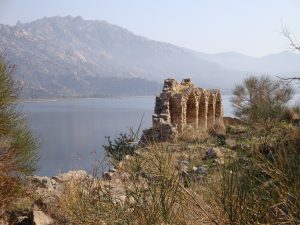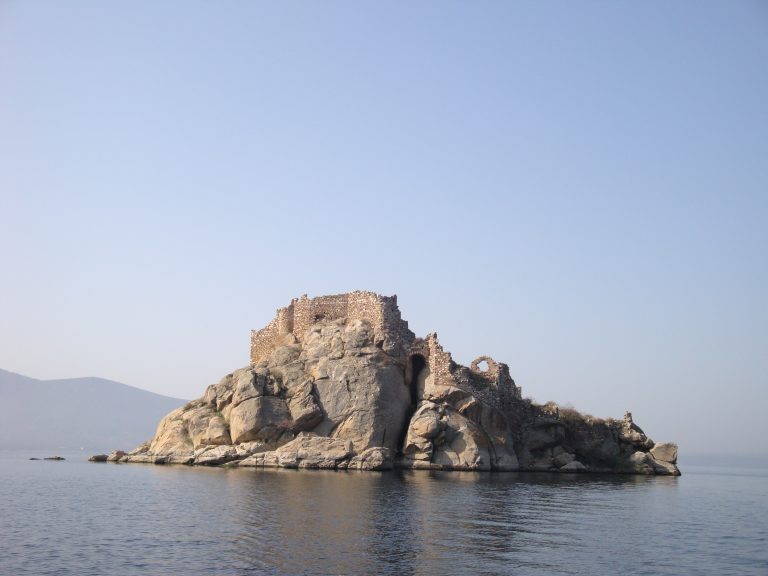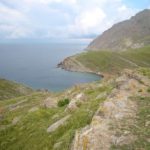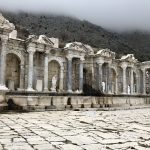Lakeside paradise Population: 350
Old name: Herakleia ad Latmos
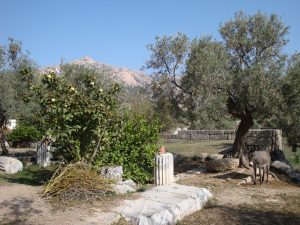 Taking a holiday in the tiny village of Kapıkırı on the shores of Bafa Gölü (Lake Bafa) is rather like staying in a giant farmyard. It’s a place where you fall asleep to the sound of a barn owl screeching across the rooftops and wake to the crow of the rooster staking out his domain. It’s a place where you will have to pause to allow groups of slow-moving cattle being herded by villagers on donkeys to pass and where the air is heavy with the scent of dung. And it’s a place where the shortest of walks amid the ruins of ancient Heracleia ad Latmos (Heraklia) is likely to be made in the company of a mixed bag of mongrel dogs, their progress around the village watched with wary eyes by an equally ragtag collection of cats.
Taking a holiday in the tiny village of Kapıkırı on the shores of Bafa Gölü (Lake Bafa) is rather like staying in a giant farmyard. It’s a place where you fall asleep to the sound of a barn owl screeching across the rooftops and wake to the crow of the rooster staking out his domain. It’s a place where you will have to pause to allow groups of slow-moving cattle being herded by villagers on donkeys to pass and where the air is heavy with the scent of dung. And it’s a place where the shortest of walks amid the ruins of ancient Heracleia ad Latmos (Heraklia) is likely to be made in the company of a mixed bag of mongrel dogs, their progress around the village watched with wary eyes by an equally ragtag collection of cats.
For most people Bafa Gölü is a glorious expanse of blue that they whip past en route from Selçuk to Bodrum, and where, perhaps, they might pause for a meal at a restaurant overlooking the remains of a Byzantine monastery marooned on an off-shore island.
Kapıkırı lies at the southern end of the lake and the authorities seem determined to ensure that as few people as possible get to see it since the dolmuş that used to link the village to the main road is no more. Still, for those who do make the effort this is an unforgettable slice of deepest rural Turkey surviving within an hour or so’s drive of the coastal madness.
Unfortunately, the rural tranquillity is now under threat from mining in the vicinity.
Backstory
Not much is known about ancient Heracleia and archeologists suspect that the extensive remains make it appear more important that it actually was, most power in the region having been monopolised by Miletus, a little further to the north.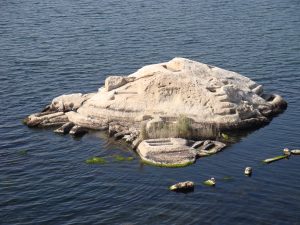
Its fate was sealed, in any case, by the changing shape of the shoreline. Bafa Gölü was originally an inlet in the coast, but over time the Büyük Menderes (Meander) river deposited so much silt along the side of it that eventually it was cut off to form a lake, leaving Heracleia with no direct access to the sea.
Hard though it is to believe it, what is now such a serene setting seems to have been a place of constant strife in the early Middle Ages, as evidenced by the ruins of many Byzantine castles both on the shore and on the islands in the lake. The first of these castles bestrides a headland signposted as you come into the village. The ruins make a wonderful spot from which to get your bearings, and to look down on the remains of ancient Carian rock tombs cut into a tiny off-shore islet.
Kapıkırı itself sits in the shadow of the Beşparmak (Five-Fingered) Mountains, an extraordinarily craggy range, which might as well have been named Onparmak (Ten-Fingered) or Yüzparmark (One Hundred-Fingered) for all you will be able to make out any specific peaks.
But what makes Kapıkırı so special is that the surrounding terrain is a mass of rocks and boulders, amongst which stand the remains of a settlement dating back to the time of the Greek colonies that used to dominate this stretch of the Aegean. Rocks and ruins are so closely intertwined that sometimes it’s hard to tell them apart. It’s something that the area shares with better-known Cappadocia, although here the scenery is much more lush and green, the surrounding fields full of venerable old olive trees.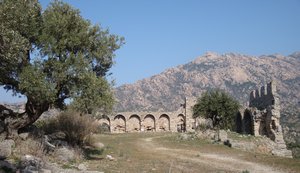
In as far as Heracleia ad Latmos is famous for anything, it’s famous as the supposed setting for one of the best-known of all Greek myths. It was here that an especially handsome shepherd boy called Endymion asked Zeus to grant him eternal youth and beauty, although in the usual way of things mythological he paid a heavy price for his pleasure by having to endure endless sleep in a cave on Mt Latmos in return.
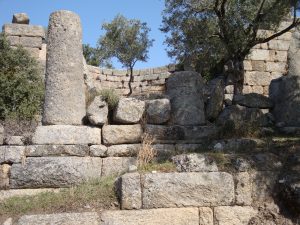 Endymion was spotted by the moon goddess Selene who fell in love with him. Despite his perpetual sleepiness, nothing could stand in the way of the determined goddess who made love to him as he slept, fathering fifty daughters by him before her passion was spent.
Endymion was spotted by the moon goddess Selene who fell in love with him. Despite his perpetual sleepiness, nothing could stand in the way of the determined goddess who made love to him as he slept, fathering fifty daughters by him before her passion was spent.
Today, what is thought to have been a shrine to Endymion, a small temple with an apse fronted by five pillars, stands guard over the lakeshore, not far from the inevitable Selene’s Pension.
But there’s much more to see in Kapıkırı than just the shrine. Signs about the village point to a bouleterion (council house), a group of column bases in someone’s backyard and to an agora (market place) which stood where once there was a village school-house, itself now ancient history; the most imposing structure here is a hefty wall pierced with windows that runs alongside the old playing field.
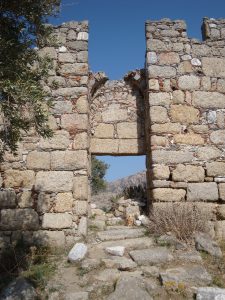 From here it’s also possible to see the shell of an ancient temple to Athena standing alone on a bluff overlooking the lake. Scant remains of an ancient theatre can just about be picked out amid boulders that lie scattered behind the village, and it’s also possible to make out stretches of the Hellenistic walls and towers that once extended for 6.5km.
From here it’s also possible to see the shell of an ancient temple to Athena standing alone on a bluff overlooking the lake. Scant remains of an ancient theatre can just about be picked out amid boulders that lie scattered behind the village, and it’s also possible to make out stretches of the Hellenistic walls and towers that once extended for 6.5km.
The remains of a second castle sit just off-shore from the village’s small beach and in dry summers the water sometimes drops low enough to walk across to them. These ruins are especially romantic when seen by moonlight, but even better are those of İkizada (Twin Islands), which can be seen on boat trips out onto the lake. The most imposing can only be viewed from afar but it’s possible to land on one of the two “islands” to examine the remains in greater detail and look down on a spit of sand that joins what actually turns out to be a peninsula to the mainland.
The boat trips are a wonderful way to see some of the rich birdlife that inhabits the lake, including flamingoes that winter here amid the more common coots, grebes, egrets and herons. More than 200 species of bird have been recorded in the area which is especially popular with bird-watchers in spring and autumn.
Kapıkırı’s other treasures keep a low profile and to find them you will need to employ a local guide (pension owners are happy to oblige).
In the eighth century a large community of monks seems to have settled here, offering yet another parallel with Cappadocia. Here, too, they painted frescoes on rock-cut shrines, some of them little more than shelters, others, such as the monastery at Yediler, far more substantial. Even more unexpected – and even harder to find without help – are extraordinary prehistoric rock paintings, featuring many hands and feet, along with sketches of women with such large posteriors that they look almost like ostriches.
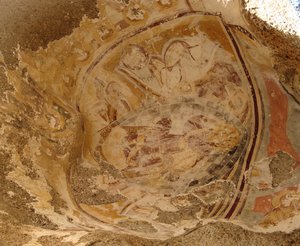 Sleeping
Sleeping
Most local pensions are fairly simple and insist on half-board terms. The breakfasts are splendid, true köy kahvaltıs (village breakfasts) with all the trimmings in keeping with the rural setting.
The following are all inside Kapıkıri, except Club Natura, which is on the other side of the lake beside the main Söke-Milas road.
Hotel Silva Oliva. Tel: 0252-519 1177
Haus Yasemin Pension. Tel: 0252-543 5598
Pelikan Pension. Tel: 0252-543 5158
Selene’s Pension. Tel: 0252-543 5221
Transport info
Regular buses and dolmuşes ply the highway between Milas and Söke. Get out at Bafa (Çamiçi) and take a taxi to the village or phone for your pension to pick you up from the junction.
The only dolmuş is timed for the convenience of locals wanting to shop in Milas rather than for visitors. On Saturday morning there is a service at 7.30 or 8am to nearby Selimiye for the market.
